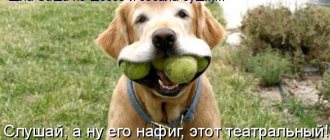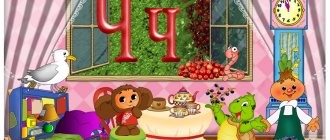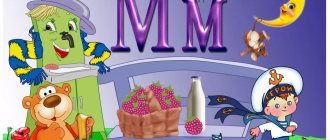Many children have typical problems with the sounds [l], [l']: “vampa” (lamp), “yoshka” (spoon), “uk” (bow), etc. This is not a complete list of characteristic omissions and substitutions that children use in their speech. Putting the sounds [l], [l'] (as well as [p] and [p']) is not an easy task and requires patience, but it is doable. This thematic section offers you a wide selection of proven methods and specific tools to achieve this goal. Here are detailed descriptions of games for correcting and honing the pronunciation of hard and soft “L”. As well as notes on speech therapy classes and educational activities for strengthening the skills of distinguishing the sounds [l], [l'] in coherent speech. And also a successful experience in involving famous fairy-tale and cartoon characters in the work of “taming” the hard and soft “L”. OLGA ate strawberries, and Kolya caught some lime.
L - L: automation, differentiation
Contained in sections:
- Letters. Getting to know letters and sounds 2687
Includes sections:
- Letters M, L and sounds [M], [L]. Lesson notes 23
- Sounds [L] - [R]. Differentiation of sounds 157
- Sounds [L], [L']. Automation, sound differentiation 698
By groups:
- Senior group
- Preparatory group
Showing publications 1-10 of 841. All sections | The letter L and the sounds [L], [L']. Class notes
New
Photo
The best
Summary of an individual speech therapy lesson “Automation of sound [L] in syllables, words, sentences” Municipal preschool educational budgetary institution kindergarten No. 1 “Rodnichok”
With.
Inzer municipal district Beloretsky district of the Republic of Bashkortostan Abstract of an individual speech therapy lesson Topic : “Automation of sound [L] in syllables , words, sentences”….
Summary of a subgroup speech therapy session with health-saving support “Differentiation [r], [l]” Summary of a subgroup speech therapy session with health-saving support. Topic: “Differentiation [p], [l]”
.
"An amusing trip"
.
Objectives: Correctional and educational: - to consolidate the skill of correct pronunciation of the sounds l , r and the ability to differentiate them in words,...
Notes on teaching literacy “letter letter l”
1st grade Teacher: Agaeva T.I.
Lesson topic: Writing a lowercase letter l.
Target
: Introducing the writing of the lowercase letter l.
Tasks:
- Educational: introduce the writing of the lowercase letter l, syllables, words and sentences;
- Developmental: develop students’ speech, the ability to answer questions with complete answers, fine motor skills of the hands;
- Educational: fostering positive motivation in educational activities.
During the classes
Lesson steps
Lesson content
1.Organizational and preparatory stage
-We came to school to learn.
Don't play and don't be lazy. Don’t yawn in class, but work and write. - Check if everything is ready for the lesson, put your workspace in order.
- If we did everything correctly, we can continue the lesson further.
2. Main stage
- Now we have a writing lesson, let's remember what we learned in the reading lesson? (learned to read words with the letter l)
Now we will stretch our fingers. Color over the areas with the letter L with a brown pencil. Whoever paints it correctly will get a picture. We work quickly, carefully, carefully (I give 2 minutes of time for work.), What did you get?
-Horse. What sound does the word horse begin with? How many syllables are there in this word? Sounds?
Remind me what sound the word horse begins with? What letter do we use to denote this sound? What types of letter L are there? (uppercase and lowercase).
We got acquainted with the printed letter L, and what letters do we write on the letter?
- What do you think we should learn in class? (In the writing lesson we will write lowercase l, syllables, words, sentences with this letter).
— What should you remember in a writing lesson? (We must sit correctly and write beautifully.)
- Let's ask the attendants to tell us how to work in a writing lesson. Let's remember the rules (write beautifully, sit up straight, notebook lies at an angle, hold the pen correctly)
Posting new material
Preparing to write the lowercase letter l
Introducing the written letter l.
- Look at the lowercase letter l on the board.
- Compare written and printed letters. What is the difference. (a printed letter has 3 elements, and a written letter has 2; a printed letter has straight, sharp lines, while a written letter has smooth, slanted lines)
— What elements does the lowercase letter l consist of? (from two small lines with curves)
-Now take your pens. Open the copybook on page 23. Circle the 2 elements at the top using the dots, look at the direction of the arrows.
— Children, what should we call the girl who is depicted in your copybook? The name should start with L, since we are now learning this letter. (Lena)
There is a pattern next to it. Determine by the pattern what it does? Is it possible to pick large bouquets of flowers? Why? (It is impossible, because it causes great harm to nature). Let's outline the pattern.
Learning to write the lowercase letter l
.
1) Writing the elements in copybook.
- First, let's write the letter l by elements, as shown in the copybook.
1 email – We start writing just above the bottom line of the working line, draw it down to the bottom line, round it, smoothly to the right, draw it upward to the top line of the working line.
2 el. – from the top line of the working line, draw a short inclined line down to the bottom line of the working line and round it just below the middle of the working line.
2) An imaginary letter “in the air.”
- Write with me.
We start writing just above the bottom line of the working line, draw down to the bottom line, round it off, smoothly to the right, draw up an inclined line to the top line of the working line and, without stopping, write a straight slanted line with a curve at the bottom to the right..
- Write the letter l according to the model, in dots, now write the letter l to the end of the line, keeping the same distance between the letters.
- Find the most beautiful letter, underline it.
Fizminutka
: music. "Two arms"
d) Consolidation of acquired knowledge
Learning to write syllables and words according to a copybook model.
1) Letter of syllable. What are words divided into (syllables), what does a syllable consist of (from a vowel sound, from a vowel and a consonant, but always from a vowel)
- And now you and I will write syllables and words with the new letter l.
- Read the syllables in the copybook. Let's see what connections these syllables have.
- Now write the syllable according to the example in the copybook.
— Raise your hand, whoever succeeded in following the example.
2) Writing the word.
- Read the word. Let's say this word in unison. How many syllables are in a word?
Finger gymnastics.
Two cheerful frogs do not sit for a minute -
The girlfriends jump deftly, only the splashes fly upward.
3) Offer letter
- Read the sentence in the copybook.
— What sign is at the end of the sentence? What does the question mark tell us? (you have to ask)
— How many words are there in a sentence?
- Read 1 word, 2 word, 3 word. — How should you write the first word?
— Why is the word Nina capitalized? We are writing a proposal.
Find the working line; write the letter L to the end of the line.
3.Final stage.
- Look at your work. Compare the letter l with the example. Has everyone learned to write this letter?
Letter from dictation: T,i,k, A,u,o,N,l.
- Who among you guys will tell us what we learned about this letter and what we did with it in the writing lesson?
- Rate yourself, show with your fingers how much you would give yourself for the lesson.
Fun party
The last day of the year has arrived. Lyudmila was waiting for guests for dinner. How many things does a young housewife need to do?
First, she ran to the store, then washed all the dishes. Lyudmila installed a Christmas tree in the corner of the room and hung light bulbs on it.
“Just to make it in time for dinner!” - flashed through her head. Lyudmila baked a turkey in the oven, made several salads, and then put sweets and apples in a vase. All that remained was to put on a new dress.
The tired housewife lay down on the sofa for a minute... Lyudmila did not hear the calls.
When the New Year arrived, she slept soundly!
Unusual peg
Pavel planted a small apple tree in the garden. The trunk of the apple tree was thin - just like that, it would break. Pavel made a stake and stuck it in the ground near the apple tree. Pavel connected the weak trunk of the apple tree and the peg with a bandage. I tied up the apple tree and calmed down. All that was left was to wait for the green leaves.
Every day Pavel went to the apple tree and watered it. I watched the branches carefully. But there were still no green leaves!
One day Pavel saw from the window that his apple tree had finally turned green. When Pavel came closer, it turned out that it was on the peg, and not on the apple tree, that several green leaves appeared! “That’s a peg!” - Pavel thought.
It's a pity!
It was summer. Volodya’s mother left home on business. She left her son some money and told him to go to the store. Volodya had to buy two packages of milk, two packs of butter and a package of sour cream.
Volodya took his bag and went to the store. He bought butter, sour cream and milk. When Volodya entered the entrance, the boys he knew called out to him: “Volodya, come out, let’s play football!”
Volodya flew into the kitchen, threw his bag on the floor and immediately ran out into the street. After half an hour in a warm place, without a refrigerator, the milk turned sour, the butter began to flow, and the sour cream became liquid and tasteless.
What a pity!
Bad thing
A small kitten was sitting on the steps at the entrance. Near him, with his head down, stood a large dog - a Dalmatian. The dog barked angrily at the kitten.
Not far away, on a bench, sat Vlad, the dog’s owner. He looked at his dog and smiled. The little kitten cowered and squeaked.
An elderly woman came out of the entrance. She picked up the kitten and commanded the dog: “Ugh! It is forbidden! Go away!" Then the woman came up to Vlad and said: “I found myself some fun! And aren’t you ashamed?” Vlad replied: “What? I did not do anything!" “That’s what’s bad!” - the woman remarked.
striped stick
Vladik walked with Polkan and constantly threw a stick at him. Polkan did not want to carry a stick. Then Vladik himself began to run after the stick. He knelt down, picked up a stick from the ground with his teeth and carried it to Polkan. Yes, studying was hard!
Once Vladik threw the stick especially far. Polkan was not seen for a long time. Finally, Vladik noticed that Polkan was carrying a stick in his teeth. The owner smiled contentedly. When Polkan came closer, Vlad saw in his mouth... a striped police baton!
Speech gymnastics
Articulation gymnastics is a set of exercises aimed at developing the organs of speech and hearing. Regular training of this kind will help you learn to pronounce any sounds correctly and clearly, including “L”:
- "Active dating" Introduce your baby to all the organs that are involved in conversation: lips, tongue, cheeks, palate. Ask your child to sit in front of the mirror and carefully look at what is where and how it can move. During the process, the baby will quietly warm up the oral organs, warm them up and prepare them for classes.
- Correct breathing. Most of the letters are pronounced while exhaling. And in order for the pronunciation to be clear and clear, it is necessary to control the amount of air. A child's favorite breathing exercises may include blowing soap bubbles or balloons, floating paper boats, or blowing out candles.
- Smile. It is important to remember that the L sound must be pronounced with a wide smile. Invite your child to smile with his mouth closed from ear to ear and hold the grimace for 10 seconds.
A number of scientific studies have proven that fine motor skills of the hands directly affect the formation of children's speech. If you want your child to speak sounds beautifully and to deliver his speech correctly, buy him small toys and plasticine.
Before starting exercises for pronouncing the sound “L”, you should show your baby the correct position of the articulatory organs:
- The tip of the tongue is located at the base of the upper teeth or alveoli, and it can also rest against the space between the jaws.
- The exhaled air should pass along the sides of the tongue.
- The sides of the tongue do not touch the cheeks and chewing teeth.
- The root of the tongue is in an elevated position, the vocal cords are tense and vibrate.
- The soft palate covers access to the nasal cavity.
Usually, a child does not have any particular difficulties mastering the mechanism of pronouncing the sound L, so a visible result is observed after just a few lessons.
How little Zlata became big
Little Ella really wanted to become big. She did everything for this! She put on my mother's high-heeled shoes. She curled her hair. She put beads around her neck. She even let her lips down with lipstick. But everyone in the house still called Ella baby.
One day Ella herself washed all the dishes in the kitchen and swept the floor. And then I made an omelette! And then suddenly dad said to mom: “Our Ella has become very big!”
Apparently, it’s not heels and lipstick that make people big!
Sound correction [l] at home
Speech disorders occur for various reasons. In the case where the child does not speak only one or two sounds, parents can try to correct the defect themselves.
Classes with a speech therapist will help correct any speech problems
How to teach a child to say the letter L hard
With dyslalia, children have problems only with sound pronunciation. Violations arise due to structural features of the articulatory apparatus or insufficient muscle preparation.
For the sound [l], the upper rise of the tip of the tongue is important. This is difficult to do with a short hyoid frenulum. Therefore, it must first be trimmed by a dentist. Only surgery will solve this problem.
It’s easy to check the ligament: you need to ask the child to touch the upper teeth with the tip of his tongue. Sonoras ([l], [r] and their soft pairs) appear by the age of five and until that time there is nothing to worry about. At three years old, the child’s articulatory apparatus is still developing.
Important! There is no need to rush and demand that children pronounce all sounds from an early age. Otherwise, you can provoke the development of a defect.
At home, you can try to correct the incorrect pronunciation of the sound [l] yourself. This is only allowed in the case of dyslalia. Sometimes this problem can be confused with dysarthria, which requires work with a speech therapist.
With dysarthria, the mobility of the muscles of the articulatory apparatus is impaired. A similar problem is expressed in hypertonicity or hypotonicity. Often the tongue of such a child is bunched up in the mouth or is too relaxed. It will be difficult for your baby to perform fine movements and switch from one position to another.
Correcting incorrect pronunciation may take up to one year. You need to work with your child every day - this will speed up the process. It is necessary to follow the sequence of stages and not rush.
Sound production
The mechanical method is often used in speech therapy. It requires a special probe in the form of a wire frame or a spatula. The child opens his mouth wide, pronounces “YYYYYY” in a drawn-out manner, and at this time the adult lifts his tongue with an instrument.
It is easier to teach a child to pronounce a sound from the interdental position. To do this, the preschooler is asked to bite the tip of the tongue and pronounce the sound [s] (YYYYYYY), and then gradually remove the tongue behind the upper teeth.
You can pronounce [l] in the interdental position immediately with syllables. Gradually we are moving away from this situation. Automation begins only with direct syllables: LA, LO, LY, LE.
Important! You cannot rush to move on to words, otherwise defective pronunciation will become entrenched.
Speech therapy chants, exercises, songs for children 2-3 years old.
Sound Automation
After the correct pronunciation has been worked out in forward and backward syllables, they move on to words. To facilitate perception, visual material is used in the form of pictures and special games. For example, a child is asked to show objects with the sound [l].
Syllables can be pronounced using a probe
It is difficult to teach a preschooler to exercise self-control. Therefore, you need to constantly work with him. It is enough to devote less than half an hour to work and the effect will not be long in coming.
Parents should understand that there is no method that will give quick results. Only constant training will help you consolidate correct pronunciation.
Songs and rhymes
To facilitate the automation process, different lexical material is used. Pure sayings and poetic forms are easier to remember and the child likes to reproduce them.
You can talk to a preschooler about different topics. This will make it easier for him to get used to the correct pronunciation.
Example of poems for sound automation [l]
The main condition for effective classes is the interest of the student. Therefore, everything is carried out in a playful way. The more varied the material, the better for the baby.
Tongue Twisters
The most difficult thing is to introduce sound into independent speech. To facilitate the process, tongue twisters using the sound [L] are used. They contain words that allow you to practice sound pronunciation in different positions.
For example, “There are pins at the Christmas tree”, “Will in the field”, “I went to Luka’s tray, Luka bought onions from the tray”, etc. Gradually, the child is asked to pronounce each tongue twister faster. Much attention is paid to correct pronunciation.
Articulation exercises
Learning to pronounce a sound correctly begins with articulatory gymnastics. Speech therapy exercises for quickly setting sound [l]:
- The wide tongue lies behind the lower teeth, the child pronounces “YYYYYYYY” in a drawn-out manner.
- Lick your upper lip with the tip of your tongue.
- Click your tongue.
- Open your mouth wide and run your tongue along the inside of your teeth.
- Run the tip of your tongue across the roof of your mouth.
The complex is performed every day. In order for a child to learn to pronounce a sound correctly, he must do all the exercises correctly. In this case, it is important to monitor the immobility of the jaw.
Articulation gymnastics is performed strictly in front of a mirror
After all the movements are easy to perform, move on to the next stage - producing a solid sound [l]. To do this, different techniques are used. It is impossible to say in advance which one will suit a particular child.
Elk and woodpecker
The elk stood under the tree and looked at the Woodpecker. The woodpecker grabbed the trunk of the tree with its tenacious paws and deftly sat on its tail. He hollowed out the trunk and pecked out larvae and beetles from it.
“How are you, Woodpecker?” - exclaimed Elk standing under the tree. “Things are bad! - Woodpecker answered. - Jackdaw let me down. She promised not to occupy my hollow, but she did. She raised chicks in it. I was left without a home!
Elk, without thinking twice, said to Woodpecker: “Listen, gore Jackdaw.” And he started laughing. The Woodpecker understood the elk's cruel joke. After thinking, Woodpecker replied: “Not a bad idea! Just you, dear Elk, climb up my tree - together we’ll fly to Jackdaw!”
Strange Tangle
Klavdia Ivanovna was sitting on a bench and knitting. Her white cat was chasing pigeons.
Klavdia Ivanovna knitted and knitted and fell asleep. A ball of thread fell out of her palms and fell onto the sand.
The cat noticed the ball and began to roll it. Forgetting about the pigeons, the cat pushed and pushed the ball with its paws. The cat was having so much fun!.. At first the ball became very small, and then it was gone completely. The white cat searched for his ball for a long time.
Good Zlata
Zlata was sitting on a bench and eating a bun with sausage. A stray dog approached Zlata. She looked at the sausage, then at Zlata and whined quietly. It was clear from the dog's eyes that she had not eaten for a long time.
Zlata broke off half of the bun and gave it to the hungry dog. She ate everything instantly. Then the dog reached out to Zlata and began to affectionately lick her palms.
Blue scarf
Mila bought a blue scarf. It was smooth, silky, with tassels - a sight to behold! —
Mila wanted to wear a headscarf to school. When Mila took the scarf from the shelf, it turned out to be wrinkled. Mila began to iron the scarf. But then, as luck would have it, the phone rang in the kitchen. Mila ran out of the room and left the iron on the scarf...
When Mila entered the room, she realized that her blue scarf was gone!










